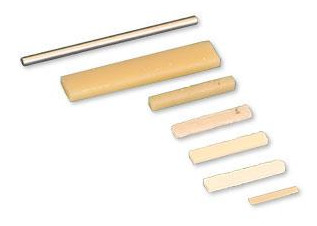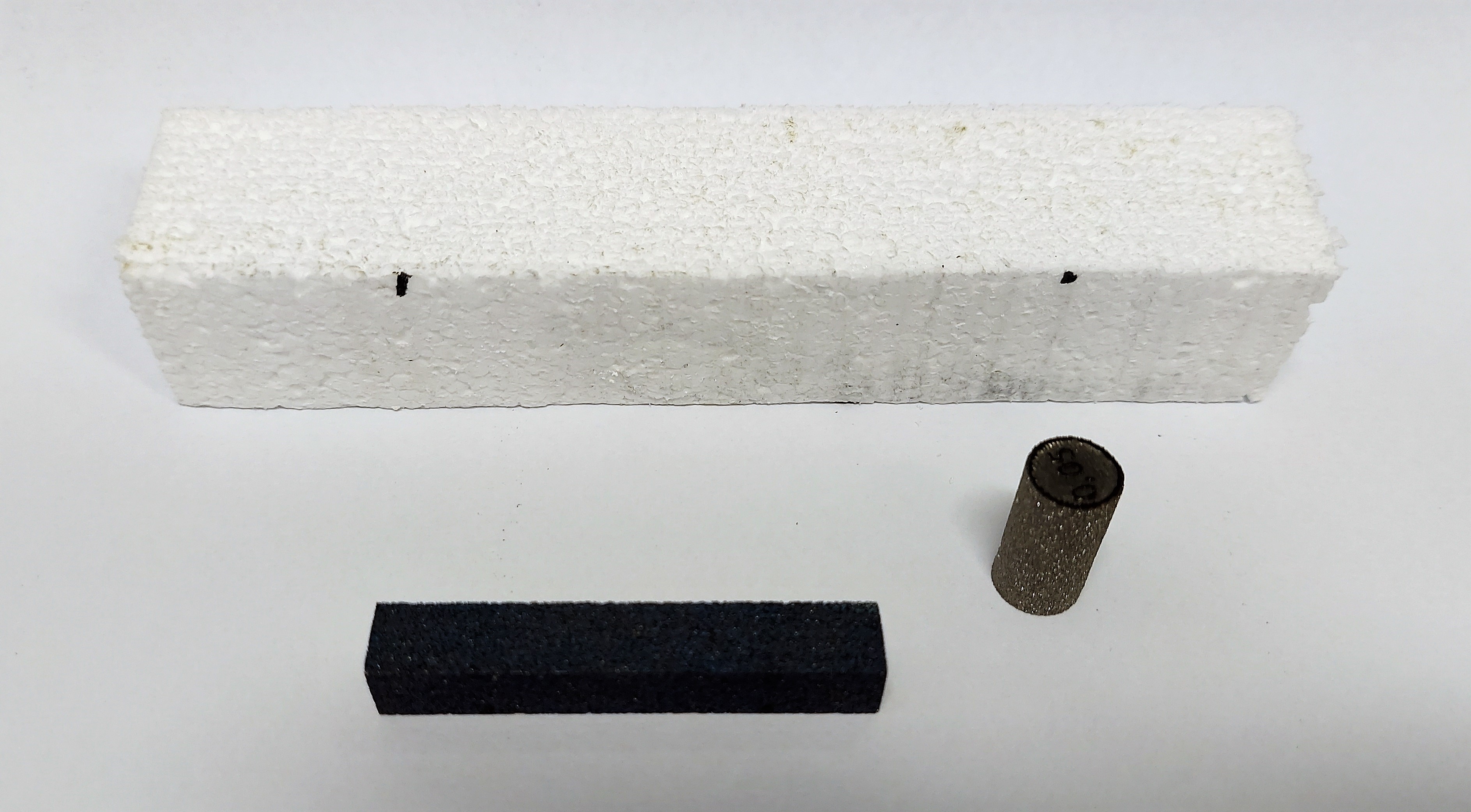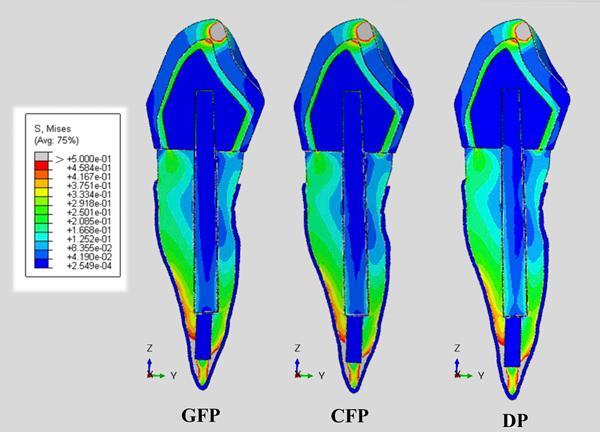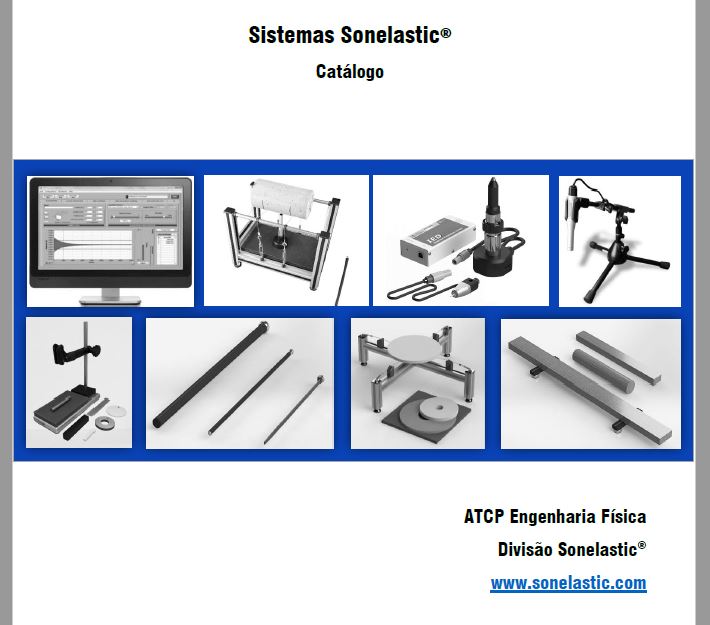Ensaios de biomateriais e polímeros
Os Sistemas Sonelastic® são uma alternativa prática e com excelente relação custo-benefício para a caracterização não-destrutiva dos módulos de elasticidade de biomateriais e polímeros. A caracterização dos módulos de elasticidade de biomateriais é essencial para a precisão de simulações pelo Método de Elementos Finitos (FEM). Alguns exemplos de biomateriais caracterizáveis são: cerâmica à base de zircônia, cerâmica feldspática, cimento resinoso, ligas de titânio, resina fotopolimerizável e hidroxiapatita.

Os Sistemas Sonelastic® empregam a Técnica de Excitação por Impulso para a caracterização precisa e não-destrutiva dos módulos elásticos (E, G e coeficiente de Poisson) e do amortecimento de materiais, e estão de acordo com a norma ASTM E1876. A caracterização dos módulos elásticos e do amortecimento revela informações sobre a microestrutura, presença e a evolução de trincas, micro trincas e defeitos no material, bem como sobre transformações de fase, processos de cura e de secagem.

Aplicações específicas
Os Sistemas Sonelastic® possuem uma ampla gama de aplicações no desenvolvimento e no controle de qualidade de biomateriais e polímeros, como:- Medição dos módulos elásticos para análises via método dos elementos finitos (FEA/FEM).
- Estudo da degradação por intempéries.
- Avaliação do impacto de tratamentos termoquímicos.
- Estudo da influência da temperatura e de cargas minerais nas propriedades mecânicas.
- Detecção de defeitos.
- Acompanhamento de processos de cura e secagem.
- Controle de qualidade.

Exemplos de aplicações dos Sistemas Sonelastic® relacionadas a biomateriais e polímeros

Aplicação: Pesquisa e desenvolvimento de biomateriais metálicos, incluindo metais porosos (scaffolds).
Contato: Prof. Dr. Conrado R. M. Afonso e Prof. Dr. Claudemiro Bolfarini.

Aplicação: P&D de biomateriais metálicos produzidos via metalurgia do pó.
Contato: Prof. Dr. Vicente Amigó Borrás.

Aplicação: Caracterização de polímeros avançados para a análise por elementos finitos (FEA) e otimização de componentes e sistemas automotivos.
Contato: Eng. Fernando Luiz Windlin.
Aplicação: Caracterização dos módulos de elasticidade de biomateriais para simulações de distribuição de tensões mecânicas em próteses odontológicas.
Contato: Prof. Dr. Ricardo F. Ribeiro
Aplicação: Caracterização dos módulos de elasticidade de biomateriais para o refinamento de simulações e análises pelo método de elementos finitos.
Contato: Prof. Dr. Alexandre Luiz Souto Borges.
Aplicação: P&D de ligas de titânio para próteses e aplicações biomédicas.
Contato: Prof. Dr. Carlos Roberto Grandini.
Aplicação: Caracterização dos módulos elásticos de vitrocerâmicas e de biovidros.
Contato: Prof. Dr. Oscar Peitl e Prof. Dr. Edgar Dutra Zanotto.
Exemplos de publicações relacionadas a biomateriais e polímeros que empregaram os Sistemas Sonelastic®
Lima, Julia Magalhães Costa et al. CAD-FEA modeling and fracture resistance of bilayer zirconia crowns manufactured by the rapid layer technology. Brazilian Dental Journal, v. 32, n. 3, pp. 44-55, 2021. ISSN 1806-4760. https://doi.org/10.1590/0103-6440202104163.
Nakano, Leonardo Jiro et al. Maximum fracture load and stress concentration in resin-bonded fixed partial dentures of indirect composite resin reinforced by silica-nylon mesh. Journal of Dental Health Oral Disorders and Therapy, 12. 96-101, 2021.
Carolina Catanio Bortolan et al. Effect of oxygen content on the mechanical properties and plastic deformation mechanisms in the TWIP/TRIP Ti-12Mo alloy. Materials Science and Engineering: A, Volume 817, 2021, 141346, ISSN 0921-5093, https://doi.org/10.1016/j.msea.2021.141346.
Laís D. Silva, Fernanda C. Puosso, Viviane O. Soares, Oscar Peitl Filho, Simone do R.F. Sabino, Francisco C. Serbena, Murilo C. Crovace, Edgar D. Zanotto. Two-step sinter-crystallization of K2O–CaO–P2O5–SiO2 (45S5-K) bioactive glass. Ceramics International, Volume 47, Issue 13, 2021, Pages 18720-18731, ISSN 0272-8842, https://doi.org/10.1016/j.ceramint.2021.03.207.
Santos, R. & Ricci, V. & Afonso, Conrado. (2021). Influence of Swaging on Microstructure, Elastic Modulus and Vickers Microhardness of β Ti-40Nb Alloy for Implants. Journal of Materials Engineering and Performance. 30. 10.1007/s11665-021-05706-3.
G.F. Ramos, N.C. Ramos, L.M.M. Alves, M.R. Kaizer, A.L.S. Borges, T.M.B. Campos, R.M. Melo. Failure probability and stress distribution of milled porcelain-zirconia crowns with bioinspired/traditional design and graded interface. Journal of the Mechanical Behavior of Biomedical Materials, Volume 119, 2021, 104438, ISSN 1751-6161, https://doi.org/10.1016/j.jmbbm.2021.104438.
Silva Dias, C., Rossi, M.C., Apolonio, E.V.P. et al. Low Mg Content on Ti-Nb-Sn Alloy When in Contact with BMMSCs Promotes Improvement of its Biological Functions. J Mater Sci: Mater Med 32, 144 (2021). https://doi.org/10.1007/s10856-021-06620-9
Isabela S. S. L. et al. Mechanical performance of monolithic materials cemented to a dentin-like substrate. The Journal of Prosthetic Dentistry. Research And Education, V. 123, Issue 5, P753.E1-753.E7, 2020. https://doi.org/10.1016/j.prosdent.2019.12.021.
Lario Femenia, Joan & Vicente-Escuder, Angel & Amigó, V.. (2021). Evolution of the Microstructure and Mechanical Properties of a Ti35Nb2Sn Alloy Post-Processed by Hot Isostatic Pressing for Biomedical Applications. Metals. 11. 1027. 10.3390/met11071027.
Borges ALS, Costa AKF, Dal Piva AMO, Pinto ABA, Tribst JPM. Effect of three different veneering techniques on the stress distribution and in vitro fatigue behavior of core-veneer all-ceramic fixed partial dentures. J Dent Res Dent Clin Dent Prospects. 2021 Summer; 15(3):188-196. Doi: 10.34172/joddd.2021.032.
Possolli, N. S. et al. Dissolution, bioactivity behavior, and cytotoxicity of 19.58Li2O·11.10ZrO2·69.32SiO2 glass–ceramic. Journal of Biomedical Materials Research Part B Applied Biomaterials 110(8), 2022. DOI: 10.1002/jbm.b.34889.
L. C. Meirelles et al. Influence of Preparation Design, Restorative Material and Load Direction on The Stress Distribution of Ceramic Veneer in Upper Central Incisor. Brazilian Dental Science, Vol. 24, No. 3, 2021. DOI: https://doi.org/10.14295/bds.2021.v24i3.2494
M. C. Rossi et al. Physical and biological characterizations of TiNbSn/(Mg) system produced by powder metallurgy for use as prostheses material. Journal of the Mechanical Behavior of Biomedical Materials, Volume 115, 2021, 104260, ISSN 1751-6161, https://doi.org/10.1016/j.jmbbm.2020.104260.
P.H.D. Ferreira, D.C.N. Fabris, M.O.C. Villas Boas, I.G. Bezerra, C.R. Mendonça, E.D. Zanotto. Transparent glass-ceramic waveguides made by femtosecond laser writing. Optics & Laser Technology, Volume 136, 2021, 106742, ISSN 0030-3992, https://doi.org/10.1016/j.optlastec.2020.106742.
L. Romero-Resendiz, P. Gómez-Sáez, A. Vicente-Escuder, V. Amigó-Borrás. Development of Ti–In alloys by powder metallurgy for application as dental biomaterial . Journal of Materials Research and Technology, Volume 11, 2021, Pages 1719-1729, ISSN 2238-7854, https://doi.org/10.1016/j.jmrt.2021.02.014.
J. E. Torrento et al. Processing and properties of Ti-15Zr-15Mo-(1-3)Ag alloys for applications as biofunctional materials. Revista Brasileira de Aplicações de Vácuo. V. 40 n. 1, 2021. https://doi.org/10.17563/rbav.v40.1189
Fiorin L, Moris ICM, Faria ACL, Ribeiro RF, Rodrigues RCS. Effect of different grinding protocols on surface characteristics and fatigue behavior of yttria-stabilized zirconia polycrystalline: An in vitro study. J Prosthet Dent. 2020 Oct;124(4):486.e1-486.e8. DOI: 10.1016/j.prosdent.2020.03.016.
Kuroda, P. A. B., Quadros, F. F., Afonso, C. R. M. et al. The Effect of Solution Heat Treatment Temperature on Phase Transformations, Microstructure and Properties of Ti-25Ta-xZr Alloys Used as a Biomaterial. J. of Materi Eng and Perform 29, 2410–2417 (2020). https://doi.org/10.1007/s11665-020-04770-5.
KURODA, PEDRO AKIRA BAZAGLIA; DE FREITAS QUADROS, FERNANDA; SOUSA, KAROLYNE DOS SANTOS JORGE; DONATO, Tatiani Ayako Goto; DE ARAÚJO, RAUL OLIVEIRA; Grandini, Carlos Roberto. Preparation, structural, microstructural, mechanical and cytotoxic characterization of as-cast Ti-25Ta-Zr alloys. JOURNAL OF MATERIALS SCIENCE-MATERIALS IN MEDICINE, v. 31, p. 19, 2020. http://dx.doi.org/10.1007/s10856-019-6350-7
FARIA, D.L.; CRUZ, T.M.; MESQUITA JUNIOR, L.; DUARTE, P. J.; MENDES, L. M.; GUIMARAES JUNIOR, J. B. Number of laminae on the mechanical behavior of glued laminated timber (glulam) of Toona ciliata produced with vegetable polyurethane adhesive. CIÊNCIA E AGROTECNOLOGIA (ONLINE), v. 43, p. 1-8, 2019. https://dx.doi.org/10.1590/1413-7054201943014819
MIRANDA, JEAN SOARES; DE CARVALHO, RONALDO LUÍS ALMEIDA; DE CARVALHO, RODRIGO FURTADO; BORGES, ALEXANDRE LUIS S.; BOTTINO, MARCO ANTÔNIO; ÖZCAN, MUTLU; MELO, RENATA MARQUES DE; SOUZA, RODRIGO OTHÁVIO DE ASSUNÇÃO E. Effect of different loading pistons on stress distribution of a CAD/CAM silica-based ceramic: CAD-FEA modeling and fatigue survival analysis. Journal of the Mechanical Behavior of Biomedical Materials, v. 94, p. 207-212, 2019. http://dx.doi.org/10.1016/j.jmbbm.2019.03.011
BARBON, FABÍOLA JARDIM; MORAES, RAFAEL R.; ISOLAN, Cristina Pereira; SPAZZIN, ALOÍSIO ORO; BOSCATO, NOÉLI. Influence of inorganic filler content of resin luting agents and use of adhesive on the performance of bonded ceramic. JOURNAL OF PROSTHETIC DENTISTRY, v. 122, p. 566, 2019. http://dx.doi.org/10.1016/j.prosdent.2019.09.013
ELIAS, CARLOS NELSON; FERNANDES, DANIEL JOGAIB; SOUZA, FRANCIELLY MOURA DE; MONTEIRO, EMÍLIA DOS SANTOS; BIASI, RONALDO SÉRGIO DE. Mechanical and clinical properties of titanium and titanium-based alloys (Ti G2, Ti G4 cold worked nanostructured and Ti G5) for biomedical applications. Journal of Materials Research and Technology-JMR&T, v. 8, p. 1060-1069, 2019. http://dx.doi.org/10.1016/j.jmrt.2018.07.016
CORREA, G; BRONDANI LP; WANDSCHER VF; PEREIRA, GK; VALANDRO LF; BERGOLI, CD. Influence of remaining coronal thickness and height on biomechanical behavior of endodontically treated teeth: survival rates, load to fracture and finite element analysis. JOURNAL OF APPLIED ORAL SCIENCE (ONLINE), v. 26, p. 1-11, 2018. http://dx.doi.org/10.1590/1678-7757-2017-0313
M.T. SOUZA, G. PENARRIETA-JUANITO, B. HENRIQUES , F.S. SILVA, A.P. NOVAES DE OLIVEIRA , J.C.M. SOUZA. Lithium-zirconium silicate glass-ceramics for restorative dentistry: Physicochemical analysis and biological response in contact with human osteoblast. Materialia (2018), doi: https://doi.org/10.1016/j.mtla.2018.07.020
SCHWANTZ, JÚLIA K.; OLIVEIRA-OGLIARI, ALINE; MEEREIS, CARINE T.; LEAL, FERNANDA B.; OGLIARI, FABRÍCIO A.; MORAES, RAFAEL R. Characterization of Bis-Acryl Composite Resins for Provisional Restorations . Brazilian Dental Journal, v. 28, p. 354-361, 2017. http://dx.doi.org/10.1590/0103-6440201601418
GOMES, E. A. et al. Reliability of FEA on the Results of Mechanical Properties of Materials. Braz. Dent. J. 2015, vol.26, n.6, pp.667-670. ISSN 0103-6440. http://dx.doi.org/10.1590/0103-6440201300639
Silva, l.H. et al., FEA and microstructure characterization of a one-piece Y-TZP abutment. Dental Materials, Volume 30, Issue 11, 2014, Pages e283-e288. ISSN 0109-5641, http://dx.doi.org/10.1016/j.dental.2014.05.016
RIPPE, Marilia Pivetta et al. Root Canal Filling: Fracture Strength of Fiber-Reinforced Composite-Restored Roots and Finite Element Analysis. Braz. Dent. J.. 2013, vol.24, n.6, pp.619-625. ISSN 0103-6440. http://dx.doi.org/10.1590/0103-6440201301996
DIANA, H. H. et al. Stress Distribution in Roots Restored with Fiber Posts and An Experimental Dentin Post: 3D-FEA. Braz. Dent. J.. 2016, vol.27, n.2, pp.223-227. ISSN 0103-6440. http://dx.doi.org/10.1590/0103-6440201600666
CANEPPELE T.M.F. et al. Bond strength of composite repairs using flowable, conventional resins or the association of both. Braz Dent Sci 2012 out./dez.; 15 (4). http://dx.doi.org/10.14295/bds.2012.v15i4.855
Martins Júnior, J.R.S., Matos, A.A., Oliveira, R.C., Buzalaf, M.A.R., Costa, I., Rocha, L.A., Grandini, C.R., 2017. Preparation and characterization of alloys of the Ti–15Mo–Nb system for biomedical applications. J Biomed Mater Res Part B 2017:00B:000–000. http://dx.doi.org/10.1002/jbm.b.33868
P. R. Monich, F. V. Berti, L. M. Porto, B. Henriques, A. P. Novaes de Oliveira, M. C. Fredel, J. C.M. Souza. Physicochemical and biological assessment of PEEK composites embedding natural amorphous silica fibers for biomedical applications. Materials Science & Engineering C (2017). http://dx.doi.org/10.1016/j.msec.2017.05.031
NERY, F., GEMELLI, E., CAMARGO, N.H.A., HENRIQUES, V.A.R.. Preparação e caracterização de um biocompósito obtido pela mistura de hidreto de titânio com nitrato de cálcio para implantes dentários. Matéria (Rio J.). 2016, vol.21, n.3, pp.742-755. ISSN 1517-7076.

